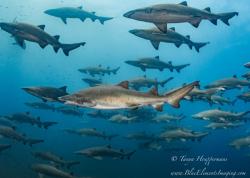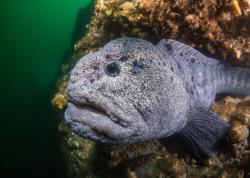The Gentle Giants of the Pacific Northwest
On a cold, winter night in West Seattle, two young men prepare to go scuba diving. Slipping beneath the dark water, they are in search of something very special. And after a 10-minute swim, at more than 100 feet beneath the surface, they find it.
Pilings, lashed together, lay along the bottom – remnants of a time when this part of Elliott Bay was a deep-water port. Buried beneath them, in a den carefully sculpted to provide minimal access, lies a female Giant Pacific Octopus, or GPO. Hanging from the top of her den, draped like pale yellow beaded curtains, hangs her nearly 100,000 eggs, each about the size of a grain of rice. Gently caressing them to keep algae-free, using her syphon to aerate them, her only goal in life is to care for her eggs until they hatch. And then she dies.

The Beginning and the End
Typically solitary creatures, the GPO only mates once in its lifetime. The male deposits a sperm sac inside the mantle of the female. The sac has a thick protective coating because she may carry it for months before she is ready to fertilize her eggs. The male will die shortly after mating.
The female finds a suitable den and deposits her eggs in strings that she attaches to the top of the den. Then she spends the rest of her life caring for her eggs. She will not leave the den, will not eat, and slowly wastes away while attending to her offspring. Many females die before their eggs hatch, but if she survives the seven to eight month incubation period she will die almost immediately after the hatching takes place.
Upon hatching, the baby octopuses measure about a quarter-inch – roughly the size of a common house-fly. As they exit the egg casings, their mother uses her syphon to blow them free of the den. The new hatchlings make their way to the surface, where they spend the first few weeks of their lives in a larval state, growing by eating plankton. During this fragile time of their lives, most of them will become prey for fish and sea birds. After a four to six week period, those who survive will settle back to the ocean floor. If they survive predation, they will spend the next two years growing to adulthood. Eventually, of the scores of thousands of hatchlings, only a handful will survive to become adults.

Living Legends
The Giant Pacific Octopus is the stuff of legends in the Pacific Northwest. Despite their short life-span of 3 to 5 years, there have been decades-old tales of “the largest octopus in the world” living underneath the Tacoma Narrows Bridge. But the reality of these creatures is no less amazing than the folklore, and very few experiences thrill a scuba diver more than a chance encounter with one of these gentle giants of the deep.
An adult GPO can grow to be larger than 20 feet across, weighing more than 150 lbs. With the ability to change skin color to express mood, and skin that enables it to change its texture to mimic its surroundings, the GPO is one of the most peculiar species on the world. It has three hearts, nine brains, blue blood, and carries its stomach where you’d expect its head to be. It has taste receptors in each of its more than 1500 suckers, which it uses to help find and identify prey. Its diet consists primarily of crustaceans such as crabs and shrimp, mollusks such as clams and mussels, and even other species of octopus. It has a prodigious appetite, consuming up to 4% of its bodyweight in food each day. Once captured, the GPO uses its hard beak to inject a toxic saliva to paralyze its prey and aid the digestion of its flesh. Then the octopus settles into its den for a leisurely meal. After eating the flesh it discards the remains into a rubbish pile, called a midden, just outside its den. Divers often use the midden to identify the location of an octopus den, which could otherwise be so well hidden that it would be difficult to find.
Much is yet to be learned about the enigmatic GPO. It is thought to be highly intelligent. A GPO displays unique personality traits, can solve problems and puzzles, and can even recognize humans it has had previous contact with. Author Sy Montgomery in his book The Soul of an Octopus said, “There’s not a creature more unlikely on this Earth it seems, and yet here’s somebody who can look you in the eye and recognize you.”

Threats and Conservation
Because Giant Pacific Octopuses are only found in coastal areas along the northern parts of the Pacific Ocean, the biggest threats to the GPO are primarily human-made. They include pollution due to development, changes in water and ocean acidification due to industrialization, the burning of fossil fuels, and low-oxygen (“dead”) zones created by an overabundance of phytoplankton and macroalgae.

Scuba divers travel from all over the world hoping for a chance encounter with the Giant Pacific Octopus in its natural environment. In 2013 the Washington State Department of Fish and Wildlife designated seven areas as protected for the Giant Pacific Octopus. These areas were recognized as popular nesting grounds, and places for scuba divers to interact with and witness the miraculous life cycle of these amazing animals.
RECOMMENDED ARTICLES
SUPPORT THE UNDERWATER PHOTOGRAPHY GUIDE:
The Best Service & Prices on u/w Photo Gear
 Visit Bluewater Photo & Video for all your underwater photography and video gear. Click, or call the team at (310) 633-5052 for expert advice!
Visit Bluewater Photo & Video for all your underwater photography and video gear. Click, or call the team at (310) 633-5052 for expert advice!
The Best Pricing, Service & Expert Advice to Book your Dive Trips
 Bluewater Travel is your full-service scuba travel agency. Let our expert advisers plan and book your next dive vacation. Run by divers, for divers.
Bluewater Travel is your full-service scuba travel agency. Let our expert advisers plan and book your next dive vacation. Run by divers, for divers.






























